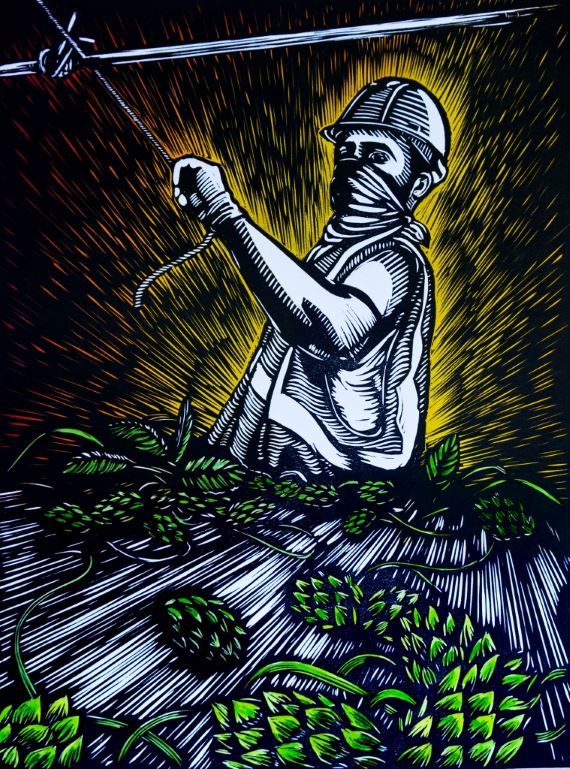Stan Hieronymus Hop Queries - August 2022 August 2022
Each month respected beer writer Stan Hieronymus produces Hop Queries, a must-read summary of what is happening in the hop world, and has kindly offered to let us publish it for Australian industry readers. If you would like to subscribe directly, you can here.
August 2022
- Powerful artwork, photos
- A hop creep solution
- New products
- What makes a hop a star?
- Suggested watching
Welcome to Vol. 6, No. 4. Hops are already being harvested at some locations across the northern hemisphere and things are about to get very busy in the US Northwest. I’m headed to Ecuador, where they don’t grow hops, but I will eventually make it to the Yakima Valley and report back next month.
Making an invisible workforce visible

As part of National Hispanic Culture Month, Dry Dock Brewing in Aurora, Colorado, will showcase the art of Christie Tirado, a Mexican American artist and elementary school art teacher in the Yakima Valley. Her block prints focus on Mexican migrant workers and Mexican Americans who work in the valley, including in the hop fields.
Tirado will discuss her art and her mission Sept. 9 at Dry Dock’s North Dock facility. The next day she will hold a block printing workshop at Denver’s Latin Cultural Arts Center. Dry Dock is producing a special beer for the event and also a T-shirt featuring her artwork. More information here.
You can see (and buy) her hop-related artwork here. At the top of the page she writes, “The purpose of my prints is to socially empower a community which has not historically been portrayed at the forefront of the hop industry.”
That is true, and why it is too bad a wider audience was not able to read a terrific story titled “Yakima Valley’s Invisible Workforce” by Jennifer Marion, accompanied by unforgettable photos by Matt Coats, written for Beer Advocate magazine in 2018. It appeared in the final issue of the magazine, the one that did not end up in print and instead was mailed as a PDF to subscribers. It is hiding in plain sight online and worth your time.
Here’s a paragraph from early in the story: “Despite increased mechanization, particularly at large farms, hops are still a very labor-intensive crop. Workers regularly spend 8 to 10 hours in the fields, up to 7 days per week, even during the hottest months. Throughout the growing season, the demand for workers ebbs and flows, with most workers needed from April to June for twining and training the hops to climb trellis poles. During the harvest from late-August through September, the work continues 24 hours per day. It’s a hard, physically demanding job that typically earns workers anywhere from minimum wage (currently $11.50 in Washington state) to a little over $14.00 per hour.” [Note: the wages paid for agricultural workers have since increased.]
And from one of the many personal stories within the article: “As with people in the local Latino community who previously immigrated to the area, H-2A workers are coming here to improve the lives of their families. ‘What we make here in the short time we are here is probably equivalent to what we would make in a year or more over there [in Mexico],’ says Jesús Lupercio, who works for Perrault Farms. His son, 20-year-old Juan Carlos Lupercio, is now working for Perrault for the first time too, leaving behind a wife and an infant daughter in Jalisco.”

In this photo, Juan Carlos Lupercio shows off a photo of his 5-month-old daughter.
Hop creep solution
When I delivered the keynote few years ago at what was then called the Beer Bloggers Conference I played a few words from a recording by James McMurtry. Introducing “No More Buffalo” on “Live in Aught Three,” he says, “I used to think I was an artist. Come to find out I’m a beer salesman.”
I suggested to the attendees that every time they post a press release verbatim that a PR person somewhere gets their wings. I think about this whenever I write about things that are new. (See next section.) Which is why, when a brewery wants to share a process they boast eradicates hop creep, reduces hop burn and retains otherwise lost delicate hop flavor I’m all in because they aren’t selling anything – other than, obviously, beer to their customers.
One Drop Brewing Company in Australia has created a web page, along with a video, that explains what they term Clean Fusion is and how it works. Commercial breweries are better equipped to use this process, but I will take the opportunity to suggest to homebrewers they need to remember the potential for hop creep, and therefore diacetyl, in heavily dry hopped beers. I judged a couple of early rounds of IPA in the National Homebrew Competition and there were several diacetyl-laced beers. Hop creep might not have been the only culprit, but was a suspect more than once.
Here is Clean Fusion described in less than 50 words.
- Ferment as usual, so if that includes dry hopping in the early days, do that.
- Reduce temperature and harvest yeast (if desired*).
- Transfer the beer through a separation/centrifuge step to remove yeast and hops.
- Dry hop the beer.
- Separate/centrifuge again into brite beer tank.
* Dry hopping at the outset of fermentation makes harvesting yeast problematic. That is another discussion.
“We use a centrifuge but we’ve also used coarse filtration before we got the centrifuge,” writes One Drop Brewing Co head brewer Nick Calder-Scholes. “The key here is separation from yeast before your large dry hop addition, not necessarily and specifically centrifuging.”
On their web page, One Drop Brewing Co explains they are sharing the process because, “We are hoping like everything else in this industry, that we will all improve on this technique together and continue to share our findings – not only in improving the character of our beers, but also the technical and stability side too.”
Calder-Scholes urges brewers to discuss this with him via email. His address is Nick@onedropbrewingco.com.au.
Speaking of new hop products
- Add Hopsauce from the New York Hop Guild to the growing list of CO2 extracted hop oil products. It was developed and is produced in house (the guild is a grower-owned merchant in upstate New York). It is flowable and designed for whirlpool additions, but suitable for use elsewhere in the brewing process. It comes in eight varieties. More information here.
- HopHaze from BarthHaas is the newest product designed to impart haze in beer. It is flavorless, odorless, does not impart sensory bitterness and is hop derived. More here. I wrote about two other options for adding haze – Haze Addition from SōRSE and HopGain Haze from Totally Natural Solutions – for Brewing Industry Guide, currently available online and soon in print.
On the horizon
It’s a listicle (sigh), but the varieties named in “What Will Be the Next Big Hop?” are well chosen contenders for the title, if there actually is going to be another big hop. That is, one grown on as many acres as Citra (11,965 strung for harvest this year) or even Mosaic (5,624 acres) – or, of course, as popular as public mainstays Cascade and Centennial were just a few years ago.
Among the varieties the USDA includes in its annual production reports (most from Hopsteiner are not), Pahto is the most planted new release since Mosaic itself was released in 2012. Growers reduced Pahto acreage to 1,700 in 2022. That’s the same as in 2018, the year the high-alpha variety valued primarily for its clean bitterness got the name Pahto. The acreage is far short of Mosaic’s.
Before my presentation at Homebrew Con, I asked several hop breeders what they thought the hops they would be releasing in 15 years might be like. I should post more complete answers here, shouldn’t I? For now, an edited thought from Shawn Townsend at Oregon State University, who does the breeding for Indie Hops. Strata and Lórien were the first two releases from the program, and newcomer Luminosa, a daughter of Sorachi Ace, will be available for spot purchases after the upcoming harvest.
“More ‘boutique’ hops that may specialize in one to a few flavors and brewers simply ‘paint’ with these specialized hops to achieve a desired flavor and aroma,” he suggested. “We’ll still have the Stratas, Citras, Mosaics and Cascades to provide a backbone for the boutique hops.”
That might be a better measure of the success of new varieties going forward.
For your viewing pleasure
This is how you pollinate a hop plant.
Hop Dreams: A Brewer’s Journey (From Firestone Walker)
Topics to explore?
Thank you for subscribing. If you have queries you’d like to see addressed drop me a line at stan@appellationbeer.com.

